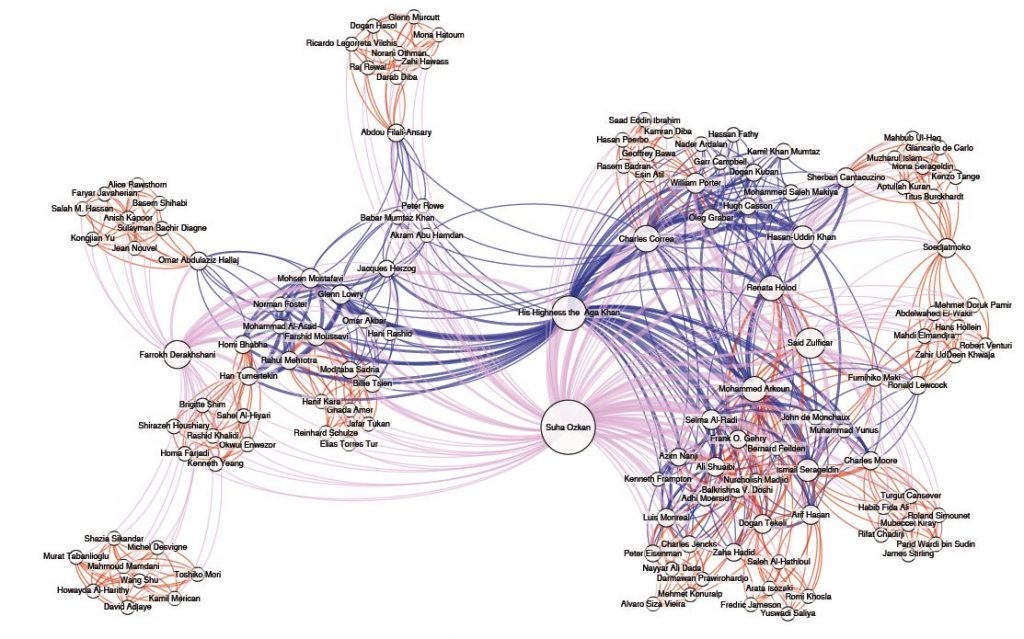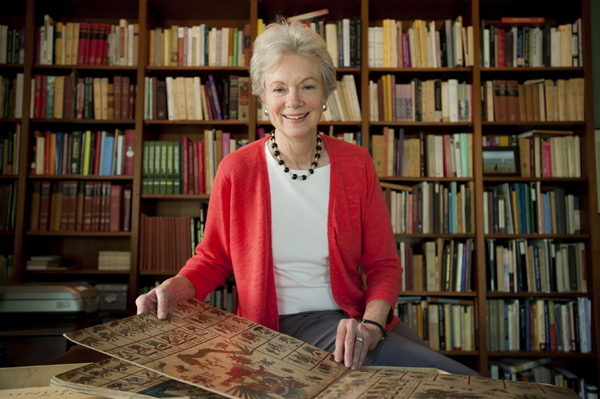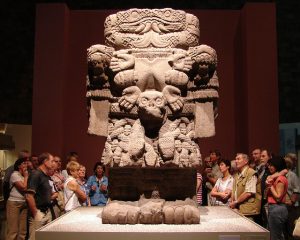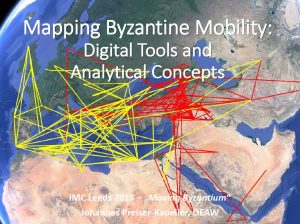CAA News Today
Barbara Bergstrom and Darden Bradshaw
posted by CAA — January 14, 2019
The weekly CAA Conversations Podcast continues the vibrant discussions initiated at our Annual Conference. Listen in each week as educators explore arts and pedagogy, tackling everything from the day-to-day grind to the big, universal questions of the field.
CAA podcasts are now on iTunes. Click here to subscribe.
This week, Barbara Bergstrom and Darden Bradshaw discuss what makes an art education program successful.
Dr. Barbara Bergstrom is an assistant professor of art education at Bowling Green State University. Dr. Darden Bradshaw is an assistant professor of art education at the University of Dayton.
Kirk Maynard and Alexandra Thomas
posted by CAA — January 07, 2019
The weekly CAA Conversations Podcast continues the vibrant discussions initiated at our Annual Conference. Listen in each week as educators explore arts and pedagogy, tackling everything from the day-to-day grind to the big, universal questions of the field.
CAA podcasts are now on iTunes. Click here to subscribe.
This week, Kirk Maynard and Alexandra Thomas discuss addressing institutionalized discrimination through artistic practice.
Kirk Maynard is a mixed media artist born in Brooklyn, New York in 1993. He received his BS in Visual Arts Education from Andrews University in 2014 and is currently an MFA student at New Jersey City University. A second generation Guyanese-American, Maynard’s work focuses on the political undercurrents of culture and identity in America.
Alexandra M. Thomas is a PhD student at Yale for History of Art and African American Studies with a certificate in Women’s, Gender & Sexuality Studies. Her current research interests include global modern and contemporary art, Black atlantic visual culture, African art, queer theory, performance studies, and Black feminist thought.
Member Spotlight: Renata Holod
posted by CAA — December 18, 2018
Renata Holod is College of Women Class of 1963 Term Professor in the Humanities, at the History of Art Department, and Curator, Near East Section, Museum of Archaeology and Anthropology, at the University of Pennsylvania. She has carried out archaeological and architectural fieldwork in Syria, Iran, Morocco, Turkey, Central Asia, Tunisia, and Ukraine, and is the author of numerous books and essays.
CAA media and content manager Joelle Te Paske corresponded recently with Professor Holod to learn more about what she’s working on.

Joelle Te Paske: Thank you for taking the time, Professor. So to begin, where are you from originally?
Renata Holod: I was born in Ukraine, and grew up in Edmonton, Alberta and then Toronto, Ontario, Canada.
I have a BA in Islamic Studies from the University of Toronto; a MA from University of Michigan in the History of Art, and my PhD from Harvard in Fine Arts.
JTP: What led you to the work you do now?
RH: My work on projects varies in date and methodology, from archaeology (I worked in Syria, and Tunisia), to architectural and regional history of different periods and locations (including fourteenth- to fifteenth-century architecture, settings and cities in greater Iran, and contemporary architecture from Morocco to Indonesia), to work on objects and collections (ceramics, the late Ottoman painter Osman Hamdi Bey). I get bored quickly.
JTP: You’ve been a CAA member for over 40 years. How has the field changed?
RH: There are many more practitioners in my particular field. In fact, it is no longer one field, but could be divided into regional and temporal sub-fields. There is much more theorization, and also expanded archival work (e.g. Ottoman archives), and now digital humanities, etc.

JTP: What is the most exciting part of your work currently?
RH: Studying unpublished objects, and redoing the galleries and publishing the Middle East collection for the later periods (Parthian through the nineteenth century) at the Penn Museum.
JTP: A favorite exhibition or study you’ve worked on over the years?
RH: Whichever one is currently being submitted.
JTP: What is your top recommendation for our readers?
RH: Network Theory and its application; see the work of my former student, Yael Rice on Mughal workshops, as well as the work of Johannes Preiser-Kappeler (Vienna).
JTP: What is a favorite memory from a CAA conference?
RH: Seeing my former students give papers; and meeting my former classmates.
JTP: Thank you, Professor Holod.
Renata Holod is College of Women Class of 1963 Term Professor in the Humanities, at the History of Art Department, and Curator, Near East Section, Museum of Archaeology and Anthropology, at the University of Pennsylvania. She has carried out archaeological and architectural fieldwork in Syria, Iran, Morocco, Turkey, Central Asia, Tunisia, and Ukraine. She is co-author of City in the Desert: Qasr al- Hayr East (1978); Architecture and Community: Building in the Islamic World Today (1983); The Mosque and the Modern World (1997); The City in the Islamic World (2008) and An Island Through Time: Jerba Studies (2009). She was recently part of the team redoing the Middle East galleries at the Penn Museum, with a special issue of Expedition magazine and a new handbook as well. Her most recent articles are: “Approaching the Mosque: Birth and Evolution” in The World of the Mosque: Magnificent Designs (New York: Rizzoli, 2017) 14-21, and “Jerba in the 3rd/9th century CE: Under Aghlabi Control?” in The Aghlabids & their Neighbors: Art & Material Culture in Ninth-Century North Africa, Glaire D. Anderson, Corisande Fenwick, and Mariam Rosser-Owen, eds. (Leiden: Brill, HdO series, 2017), 451- 469. On several international advisory and editorial boards, she has also served as President, Board of Trustees at The Ukrainian Museum in NYC, 2013-2017.
Chelsea Farrar and Heidi Herboldsheimer
posted by CAA — December 17, 2018
The weekly CAA Conversations Podcast continues the vibrant discussions initiated at our Annual Conference. Listen in each week as educators explore arts and pedagogy, tackling everything from the day-to-day grind to the big, universal questions of the field.
CAA podcasts are now on iTunes. Click here to subscribe.
This week, Chelsea Farrar and Heidi Herboldsheimer discuss Red for Ed, a grassroots movement started by parents and teachers as a way to stand up for public education.
Chelsea Farrar is Curator of Community Engagement at the University of Arizona Museum of Art.
Heidi Herboldsheimer has been teaching middle school in Arizona for seven years.
Denise Burge, Lisa Siders, and Jenny Ustick
posted by CAA — December 10, 2018
The weekly CAA Conversations Podcast continues the vibrant discussions initiated at our Annual Conference. Listen in each week as educators explore arts and pedagogy, tackling everything from the day-to-day grind to the big, universal questions of the field.
CAA podcasts are now on iTunes. Click here to subscribe.
This week, Denise Burge, Lisa Siders, and Jenny Ustick discuss interdisciplinary collaboration.
Denise Burge is an instructor of Drawing and Animation at the University of Cincinnati.
Lisa Siders is a fiber and installation artist living on Whidbey Island, Washington.
Jenny Ustick is the Interim Director of the Masters of Fine Arts Program, Foundations Coordinator, and Instructor of Drawing at the University of Cincinnati.
Sherry Muyuan He and Jonathan Aller
posted by CAA — December 03, 2018
The weekly CAA Conversations Podcast continues the vibrant discussions initiated at our Annual Conference. Listen in each week as educators explore arts and pedagogy, tackling everything from the day-to-day grind to the big, universal questions of the field.
CAA podcasts are now on iTunes. Click here to subscribe.
This week, Sherry Muyuan He and Jonathan Aller discuss working with students of diverse level skillsets in the classroom.
Sherry Muyuan He is an assistant professor of Graphic Design at the University of South Dakota. She is also an interdisciplinary designer engaging in the community with food-themed activities.
Jonathan Aller is an adjunct faculty member at Minneapolis College of Art and Design, and contemporary portraiture artist exploring community and identity in the physical and digital realm.
Jennifer Drinkwater and Karen Gergely
posted by CAA — November 26, 2018
The weekly CAA Conversations Podcast continues the vibrant discussions initiated at our Annual Conference. Listen in each week as educators explore arts and pedagogy, tackling everything from the day-to-day grind to the big, universal questions of the field.
CAA podcasts are now on iTunes. Click here to subscribe.
This week, Jennifer Drinkwater and Karen Gergely discuss social practice.
A Mississippi native, Jennifer Drinkwater is an assistant professor with a joint appointment between the department of art and visual culture at Iowa State University extension and outreach.
Karen Gergely is a West Virginia native and an assistant professor of Art at Graceland University in Lamoni, Iowa.
An Interview with Elizabeth Hill Boone, 2019 CAA Distinguished Scholar
posted by CAA — November 20, 2018
We are pleased to welcome Elizabeth Hill Boone, Professor of History of Art and Martha and Donald Robertson Chair in Latin American Art at Tulane University, as the 2019 CAA Distinguished Scholar.
An expert in the Precolumbian and early colonial art of Latin America with an emphasis on Mexico, Professor Boone is the former Director of Pre-Columbian Studies at Dumbarton Oaks and recipient of numerous honors and fellowships, including the Order of the Aztec Eagle, awarded by the Mexican government in 1990.
CAA media and content manager Joelle Te Paske corresponded with her recently to learn her thoughts on art history, scholarship, and challenges in the field. Read their interview below.

Photo: Paula Burch, Tulane University
Joelle Te Paske: Thanks for taking the time to speak with CAA. So, where are you from originally?
Elizabeth Hill Boone: Coming from a military family rooted in Virginia, I moved from coast to coast often as a child and then attended the College of William and Mary in Virginia for my BA.
JTP: What pathways led you to the work you do now?
EHB: It was at William and Mary, where I was a Fine Arts major. The sculpture professor Carl Roseberg offered a course, Ancient Art, that included a three-week section on the Pre-Columbian Americas. He showed us and presented the then-canonical explanation of the monumental “Coatlicue” sculpture from Aztec Mexico, and I was immensely intrigued. I wondered what kind of mind would conceptualize and carve a work like that as its creator or mother goddess. That question led me into Aztec studies, which took me to the University of Texas at Austin for my PhD, and to Aztec painted books, where similar images were to be found. I became a manuscript specialist because I needed to understand what the manuscript paintings meant, how they related to the Coatlicue, why they came to fill those particular pages. Since the field of Mexican manuscript painting was in its infancy, I left the Coatlicue behind to focus on the other manuscript genres and Mexican pictography as a system. My study of Mexican pictography naturally led me to the issue of how the concept of Writing should be broadened.
JTP: What are you working on currently?
EHB: I am now finishing up a book analyzing the corpus of pictorial manuscripts created in the early colonial period to document the ideologies and practices of Aztec culture. United by their decendency from Mexican pictography, these painted reflections of the Aztec past were re-purposed to inform Europeans principally about Aztec religion, as weapons of conversion and aids for colonial administrators.
JTP: What is your favorite part of the work you do?
EHB: I think most art historians love solving mysteries: discovering connections and uncovering histories and contexts. I want to understand what an object meant to its different audiences at the time of its creation, and also what it can tell us now about our own perspectives. Depending on the object, it can also be rewarding and telling to track its reception and reconceptualization through time.

Coatlicue Statue in National Museum of Anthropology, Mexico City. Photo: Antony Stanley
JTP: If you could boil your teaching philosophy down to a central idea, what would it be?
EHB: My goal is to excite students about the potentials of visual expression. This means giving them knowledge of the material such that they can understand its cultural context and power, but also showing the students how the objects speak today as works of art.
JTP: What’s exciting to you right now in the field?
EHB: Globalism. The discipline has broken the confines that once centered it in Western Europe and is now focusing on connections between peoples. Centers of discourse are now shifting toward the larger Atlantic world, the Pacific world, the Silk Road, and the trans-Mediterranean/African network, to name just a few. It is opening up new ways of understanding the meaning and agency of art.
JTP: What do you see as the greatest challenges in the field right now?
EHB: I see two challenges. The first and most important is relevance. Art history must articulate why it matters in these times. As graphic communication (communication that is not oral or gestural) becomes even more the principal form of communication between people, the discipline needs to assert its place as a source of theoretical knowledge and of models for investigative practice.
The second challenge is linked to the increasing study of trans-cultural connections. Scholars who seek to follow the movement of objects and ideas across spaces and between cultures need to develop strong local knowledge of all participants, so that these global connections are grounded in area expertise. In order to avoid facile comparisons and connections, researchers now have to master multiple areas.
JTP: Have you attended CAA conferences? Do you have a favorite memory?
EHB: I have attended many. Perhaps my favorite memories are of cross-cultural sessions that focus on issues relevant to many cultures, for example, civic identity, and in which the presenters push their material to address the large question in a serious way.
JTP: Thank you, Professor Boone. We’re looking forward to seeing you at the 2019 conference.
Elizabeth Hill Boone is Professor of History of Art and Martha and Donald Robertson Chair in Latin American Art at Tulane University. An expert in the Precolumbian and early colonial art of Latin America with an emphasis on Mexico, she is the former Director of Pre-Columbian Studies at Dumbarton Oaks. Professor Boone has earned numerous honors and fellowships, including the Order of the Aztec Eagle, awarded by the Mexican government in 1990. She is a Fellow of the American Academy of Arts and Sciences and a Corresponding Member of the Academia Mexicana de la Historia. Her research interests range from the history of collecting to systems of writing and notation, and are grounded geographically in Aztec Mexico, but extend temporally for at least a century after the Spanish invasion. She is the author of Cycles of Time and Meaning in the Mexican Books of Fate (Texas, 2007) and Stories in Red and Black: Pictorial Histories of the Aztecs and Mixtecs (Texas, 2000), which was awarded the Arvey Prize by the Association for Latin American Art.
Sissel Tolaas, Yelena McLane, and Meredith Lynn
posted by CAA — November 19, 2018
The weekly CAA Conversations Podcast continues the vibrant discussions initiated at our Annual Conference. Listen in each week as educators explore arts and pedagogy, tackling everything from the day-to-day grind to the big, universal questions of the field.
CAA podcasts are now on iTunes. Click here to subscribe.
This week, Sissel Tolaas, Yelena McLane, and Meredith Lynn discuss “Smells, Diversity, Tolerance.”
Sissel Tolaas is an artist and founder of the SMELL RE_searchLab in Berlin.
Yelena McLane is Assistant Professor of Interior Architecture & Design, Florida State University.
Meredith Lynn is Assistant Curator & Director of Galleries, Florida State University.
Elaine Bezold and Sidney Stretz
posted by CAA — November 12, 2018
The weekly CAA Conversations Podcast continues the vibrant discussions initiated at our Annual Conference. Listen in each week as educators explore arts and pedagogy, tackling everything from the day-to-day grind to the big, universal questions of the field.
CAA podcasts are now on iTunes. Click here to subscribe.
This week, Elaine Bezold and Sidney Stretz discuss failure in the classroom.
Elaine Bezold (Stephen F. Austin State University) is a photographer and educator living in Dover, New Hampshire. She makes work about human-animal interactions, rebirth, loss, and instinct.
Sidney Stretz (University of North Carolina Greensboro) is an artist and educator living and working in Greensboro, North Carolina. She makes work about everyday life and its challenges, strange social situations, and failure.



